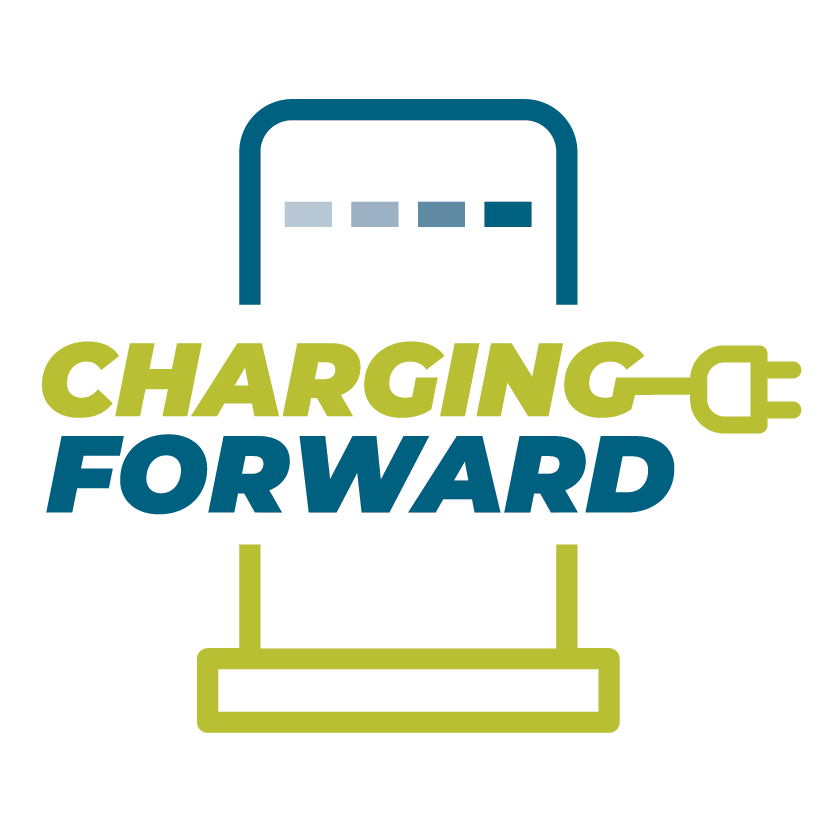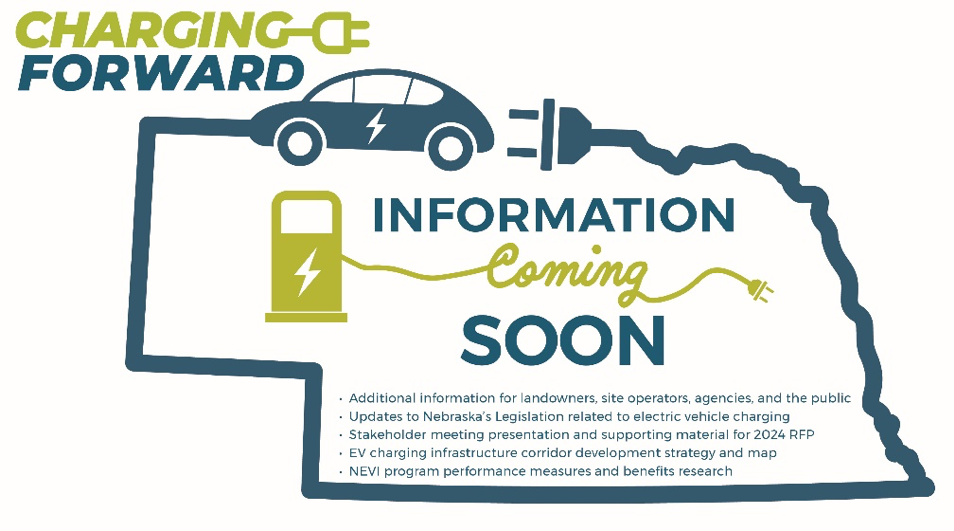
National Electric Vehicle Infrastructure Formula Program
The Bipartisan Infrastructure Law (BIL) was signed by President Joe Biden in November 2021, which includes the National Electric Vehicle Infrastructure Formula Program. It provides states with $7.5 billion to expand the electric vehicle (EV) charging network. Over the next five years, Nebraska will have access to $30.2 million (~$6 million/year) in formula funds for EV charging infrastructure while also still being able to compete for a portion of an additional $2.5 billion in discretionary grant funding. This funding supports the Administration’s goal of expanding EV charging stations along designated Alternative Fuel Corridors (AFCs) and other corridors that could be identified in the state.
These federal funds will flow through the Nebraska Department of Transportation (NDOT) and, for the first year’s funding, will be primarily focused on developing electric charging infrastructure on AFCs, which today include Interstate 80 across the state and Nebraska Highway 31 and US Highway 6 in the Omaha area. In future years, the development of the AFC Supporting Network and the AFC Extended Support Network.
With the recently approved plan, highlights include:
- Nebraska will have approximately $6 million per year for the next five years for Electric Vehicle Infrastructure
- Funds come from the Bipartisan Infrastructure Law signed on Nov. 15, 2021
- Nebraska's year one focus is on the I-80 corridor
- Charging stations for the first year’s allocated funding will consist of at least 4 DC fast charging ports located at a publicly accessible business
- Plan is reviewed and evaluated on a yearly basis
Federal Legislation
Federal Guidance and Joint Office Support
The Joint Office of Energy and Transportation was created through the BIL to facilitate collaboration between the U.S. Department of Energy and the US DOT. The Joint Office will align resources and expertise across these two federal departments toward leveraged outcomes. This office will be a critical component in the implementation of the BIL, providing support and expertise to a multitude of programs that seek to deploy a network of electric vehicle chargers, zero-emission fueling infrastructure, and zero-emission transit and school buses. The scope of the Joint Office will continue to evolve as directed by both departments.
Read more about the NEVI Formula Program Guide here.
Approved Plan
The US Federal Highway Administration (FHWA) approved Nebraska's NEVI plan in September 2022. The approved plan is required to be established according to NEVI guidance and updated annually.
- Click here to view or download the 2024 Updated NEVI plan.
- Click here to view or download the approved plan from September 1st, 2022.
- The Request for Information (RFI) process was completed between (start and end date). This provided an opportunity for input on the current proposed program. Links to the information made available during the review process are provided below.
- RFI Section I final - Project Description and Scope of Work (2 pages)
- RFI Appendix - Nebraska State Plan for Electric Vehicle Infrastructure Deployment Program Summary (9 pages)
- Stakeholder Meeting - 2/13/23 (Video) - Recorded NEVI Stakeholder WebEx Meeting
- The NEVI program requires yearly updates to each state’s plan and must be approved by FHWA. The 2023 plan update was submitted on August 1st 2023. The plan includes a section devoted to the changes between the initial plan and the year 1 update starting on page 1.
Request For Proposal
-
NEW: Click here to bid on the NEVI Formula Program - RFP is open until Nov. 4, 2024 at 2 p.m. CST
- Instructions for submittal can be found in the RFP
-
Bid Documents
Year One Plan Update
- Nebraska NEVI 2023 Annual Update
- State Agency Coordination: Section updated to include a description of coordination efforts to navigate challenges faced by Nebraska’s limitation on the sale of electricity to only public entities such as municipal utilities and public power districts.
- Public Engagement Efforts: Section updated to include a description of public engagement efforts since the approval of the NEVI plan.
- Plan Vision and Goals: Section updated to provide an overview of a methodology developed to determine NEVI funding investments following Nebraska’s AFCs being certified as fully built out.
- Contracting: Section updated to include information on efforts to develop a Request for Proposals (RFP).
- Civil Rights: Section updated to include a discussion on NDOT’s plans to ensure ADA compliance for EV chargers.
- Existing and Future Conditions Analysis: Section updated to include an additional NEVI compliant charging station and the physical addresses of existing charging stations.
- Electric Vehicle (EV) Charging Infrastructure Deployment: Section updated to include a list of planned charging locations.
- Implementation: Section updated to include more information on ensuring that current and planned charging stations are fully compliant with the requirements of the federal NEVI program.
- Equity Considerations: Section updated to include planned outreach activities and measures to evaluate the benefits of the program’s implementation.
- Labor and Workforce Considerations: Section updated to include a discussion on NDOT plans to ensure that the workforce installing electric vehicle supply equipment (EVSE) has appropriate licenses, certifications and trainings in compliance with 23 CFR 680.106 (j) and how these requirements are enforced through the state’s NEVI contracting and procurement strategies.
- Program Evaluation: Section updated to include information on the development of a program evaluation methodology.
How It Works
The Alternative Fuels Data Center through the US Department of Energy provides an interactive, filterable map of the locations of various fuel types including electric charging stations. The below map represents the information for this specifically for Nebraska. The information below is being considered with other data to consider demand and opportunities for expanding the electric vehicle charging infrastructure.

Station Locations
The two types of EV chargers utilized in the NEVI program are Level 2 and DC Fast chargers. While Level 2 chargers can bring an EV to full charge in anywhere from 4-10 hours, a DC Fast charger can do the same in often less than one hour. In the first year’s funding allocation to the buildout of the AFC, only DC fast chargers will be utilized. As the funding continues to be used, there will likely be some charging locations that utilize Level 2 chargers because installation cost is lower. These may be appropriate in areas with low density and low projected usage rates. Each station location in the below map has at least one charging port, which may have more than one connector. EVSE simply refers to the typical port that would be used in a standard EV station.
To see the full list of differences between the different types of chargers and the charging infrastructure terminology, click the Alternative Fuel Data Center link here.
Additional Resources
While we’ve provided some quick answers that pertain specifically to the Nebraska NEVI plan, here is a is of FAQs compiled by the FHWA for all stakeholders in the NEVI program.
The NEVI Final rule establishes regulations setting minimum standards and requirements for projects funded under the NEVI Formula Program and projects for the construction of publicly accessible electric vehicle chargers under certain statutory authorities, including any EV charging infrastructure project funded with Federal funds that is treated as a project on a Federal-aid highway.
While the Joint Office is the primary provider of technical assistance for the development of state plans under the NEVI program, the FHWA has provided a useful fact sheet for general financial, structural, and eligibility elements of the program.
The Joint Office was created via the BIL to facilitate collaboration between the US Department of Energy and the US Department of Transportation. They are the primary hub of resources for all NEVI information.
The Alternative Fuels Data Center (AFDC) provides information, data, and tools to help fleets and other transportation decision makers find ways to reach their energy and economic goals through the use of alternative and renewable fuels, advanced vehicles, and other fuel-saving measures.
The EV route planner operates like many other route planners – creating navigation from a set start point to the set end point. However, this tool allows the user to enter their EV type, and the route will adjust to accommodate charger locations for your vehicle and calculates total trip time including the time spent charging.
The US Department of Energy has compiled a list of the tax incentives available based on type of vehicle and the time of purchase.
List of Applicants and Locations (PDF list of 2024 applicants, whether they’re funded, and the amounts)

Frequently Asked Questions
No, NEVI provides funding to states to deploy electric vehicle (EV) charging infrastructure along public roads.
Yes, the BIL established a new $2.5 billion discretionary grant program to deploy publicly accessible EV charging infrastructure, hydrogen fueling infrastructure, propane fueling infrastructure, and natural gas fueling infrastructure.
Federal NEVI guidance currently defines EVs to include “passenger cars and light trucks.”
NEVI Formula funding to use on projects that are directly related to the charging of a vehicle and only for EV charging infrastructure that is open to the public or to authorized commercial motor vehicle operators from more than one company. Charging stations must be on the Alternative Fuels Corridor
The statutory term included with the funding criteria applied through BIL. In general, AFCs provide a series of alternative fuel distribution sites conveniently located for the traveling public to meet the emerging need for such supplies. The Federal Highway Administration solicits nominations from state and local officials and works with other federal officials and industry stakeholders to make AFC designations.
Federal funds to pay for EV infrastructure will be available soon; Nebraska will receive $30.2 million in National Electric Vehicle Infrastructure (NEVI) Formula Funds. These federal funds were approved as part of the Bipartisan Infrastructure Law (BIL) and are specifically for investments in EV facilities here and across America. If we don’t plan for EV infrastructure, that money will be spent in other states.
If you plug in an EV at your home, the electricity you use will add to your electric bill, just like plugging in a refrigerator or other appliance. If you don’t have an EV, it’s not clear that EV usage would have any impact on you or the electricity to your home or business. Public power utilities in Nebraska are an important part of planning for EVs, so that we can understand the impact of EV electricity usage.
As of June of 2023, there were approximately 4,637 EVs in Nebraska, according to the Nebraska Department of Environment and Energy.
While strides have been made across NE transit systems to further electrify fleets across the state, NEVI program funding is not eligible for electric buses or any public transit system. However, if smaller electric buses are able to charge via a standard Level 2 or DC fast charger, they may be utilized.
